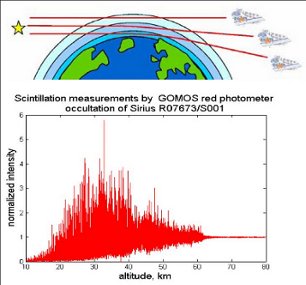Stellar Scintillations for Mapping Turbulence and Gravity Waves
The methodology for reconstruction of gravity wave and turbulence spectra parameters was developed and adapted to GOMOS scintillation data. The description of the forward model and the inversion are presented in [Sofieva et al., 2007a]. It was demonstrated [Sofieva et al., 2007a] that the following parameters can be reconstructed from GOMOS measurements: for gravity wave (anisotropic) component, the structure characteristic (strength of anisotropic fluctuations), outer scale (the dominant vertical wavelength) and the inner scale (the scale characterizing transition to turbulence), for turbulent (isotropic) component, the structure characteristic (defining the strength of isotropic fluctuations). In addition, the turbulent structure characteristic (C2T) can be estimated, and self-consistent estimates of gravity wave potential energy per unit mass can be obtained. The global distributions of gravity wave spectra parameters have been obtained [Sofieva et al., 2009b]. The global distributions of the turbulence structure characteristic C2T at altitudes 30-50 km are obtained for the first time [Gurvich et al., 2007]. The GOMOS data have shown interesting features such as the indication on gravity wave breaking in the polar night jet [Sofieva et al., 2007b]. It was demonstrated that GW parameters retrieved from scintillations are in good agreement with those from other measurements at overlapping altitudes and locations [Sofieva et al., 2009b]. In addition, during the data analysis, we found unusual scintillation spectra in occultations of the star α Cru and understood that they are because α Cru is a double star. The scintillation spectra of double unresolved by the detector stars are more complicated, but they are more informative [Sofieva et al., 2009a], and they can allow estimating the anisotropy coefficient [Kan et al., 2012].
 |
 |
Left: a schematic representation of occultation measurements (top) and an example of the scintillation recording by the GOMOS photometers (bottom); right: turbulence structure characteristic C2T at 42 km, as obtained from GOMOS scintillations, figure is adapted from [Gurvich et al., Geophys. Res. Lett., 2007].
Data requests: please contact viktoria.sofieva(at)fmi.fi.
The detailed information about the data and analyses can be found in the following publications:
1. Sofieva V. F., A. S. Gurvich and F. Dalaudier (2010): Mapping gravity waves and turbulence
in the stratosphere using satellite measurements of stellar scintillation, Physica Scripta, Vol.
2010, T142,
doi: 10.1088/0031-8949/2010/T142/014043
2. Sofieva, V. F., A. S. Gurvich, and F. Dalaudier (2009b), Gravity wave spectra parameters in
2003 retrieved from stellar scintillation measurements by GOMOS, Geophys. Res. Lett., 36, L05811,
doi:10.1029/2008GL036726
3. Sofieva, V. F., A.S. Gurvich, F. Dalaudier and V. Kan (2007a), Reconstruction of internal gravity
wave and turbulence parameters in the stratosphere using GOMOS scintillation measurements, Journal
of Geophys. Res., 112, D12113,
doi:10.1029/2006JD007483
4. Sofieva, V. F.,et al. (2007b), Global analysis of scintillation variance: Indication of gravity
wave breaking in the polar winter upper stratosphere, Geophys. Res. Lett., 34, L03812,
doi:10.1029/2006GL028132
5. Gurvich, A. S., V. F. Sofieva, and F. Dalaudier (2007), Global distribution of CT2 at altitudes
30–50 km from space-borne observations of stellar scintillation, Geophys. Res. Lett., 34, L24813,
doi:10.1029/2007GL031134
6. Sofieva, V. F., Dalaudier, F., Kan, V., and Gurvich, A. S. (2009a): Technical note: Scintillations
of the double star α Cru observed by GOMOS/Envisat, Atmos. Chem. Phys., 9, 8967-8973,
doi:10.5194/acp-9-8967-2009
7. Kan, V., Sofieva, V. F., and Dalaudier, F. (2012): Anisotropy of small-scale stratospheric
irregularities retrieved from scintillations of a double star α-Cru observed by GOMOS/ENVISAT, Atmos.
Meas. Tech., 5, 2713-2722, doi:10.5194/amt-5-2713-2012